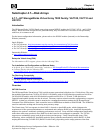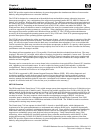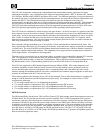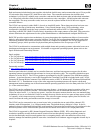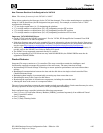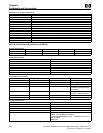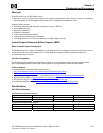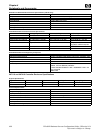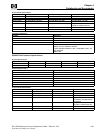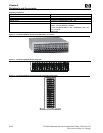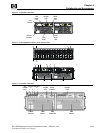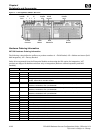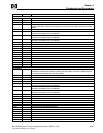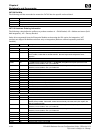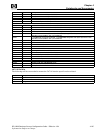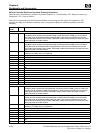
Chapter 4
Peripherals and Accessories
HP e3000 Business Servers Configuration Guide – Effective 1/04 4-93
Information Subject to Change
The VA7110 is designed to communicate with multiple hosts and multiple systems, otherwise known as
heterogeneous support. Any combination of the supported operating systems—HP-UX, Windows NT, Solaris,
AiX, NetWare, Windows 2000, MPE/iX, and Linux can be used. Two different protocols, or host port behaviors,
are used by the array to communicate with the operating systems: one protocol for Windows/Linux/other and
another for HP-UX. The Windows/Linux host port behaviors must be configured in the array for
communication to take place with any or all four supported operating systems on a controller. When changing
the port protocol to Windows/Linux it does support concurrent operation with Windows/Linux and HP-UX.
The VA7110 provides simultaneous access by all of the supported operating systems on a LUN-by-LUN basis.
Each LUN operates appropriately given the description of the operating system requirements.
The VA7110 can be configured to utilize an active hot spare feature. An active hot spare is a portion of the disk
array capacity reserved to perform a rebuild. This feature requires the use of one or two additional disk units
in the array. An active hot spare ensures that the disk array can maintain data redundancy if one or two disks
fails. Until it is needed, the disk array uses the active hot spare storage space as RAID 1+0 capacity, which
improves array performance. The active hot spare storage capacity does not sit idle; it is used to increase the
disk array performance until the storage is needed.
Each enclosure will accommodate up to 15 low-profile 3.5-inch hard disk drives loaded from the front. The
array requires three EIA units (3U) in height (per enclosure), which allows ten units to be placed in a standard
1.6-meter rack. The rear of the EIA rack mountable chassis also includes two 1-GB fibre channel controllers,
dual power supplies and dual fan modules. The redundant power supply and fan components are combined
into a single module. All modules are hot swappable.
The array can be connected to one or more hosts, hubs, or switches via an optical fibre channel (FC) interface
with 1 or 2 gigabit per second transfer rates (the default setting is 1 gigabit). It can be ordered in
factory-racked, field-rackable, or desk-side configurations. Factory-racked products are pre-configured in the
HP Rack/System E racks. Field-rackable products can be racked in HP racks or in Compaq 9000 racks.
The VA7110 is supported by HP’s Instant Support Enterprise Edition (ISEE). HP’s online diagnostic and
resolution capability securely delivers remote reactive services that quickly resolve problems, proactive
service that anticipate and prevent downtime due to computing issues, and value-added services to help
monitor, manage and maintain global IT networks. A minimum level hardware support upgrade of same day is
required. It is included with the VA for the first year.
The revision numbering for firmware for the VA7110 has changed. The revision numbering now consists of a
string of 4 ASCII characters (the HP designation has gone away). For example, a revision code of “X123”
represents the following:
• “X” is a single capital letter (A – Z) designating the platform
• “1” is a single number or capital letter (0-9, A-Z) designating a major FW revision
• “2” is a single number or capital letter (0-9, A-Z) designating a minor FW revision
• “3” is a single number or capital letter (0-9, A-Z) designating a sub-minor FW revision
VA7410 Overview
The HP StorageWorks Virtual Array 7410 is a Fibre Channel (FC) disk storage system that supports from ten to
105 disk drives. The VA7410 has two FC ports on each controller. The VA7410 is comprised of two types of
enclosures, each three EIA units high: the virtual array controller enclosure (A6183A/AZ) and the disk system
enclosure (A6214A/AZ) also referred to as the disk enclosure or the JBOD (Just a Bunch Of Disks) enclosure.
In addition, pre-defined SKUs are available to facilitate integrated arrays. The array consists of one controller
enclosure and one to six disk enclosures, with scalable capacities from 181 GB to 1.90 TB (using 18-GB 15K
rpm disk drives), 364 GB to 3.82 TB (using 36-GB 10K rpm disk drives), 720 GB to 7.67 TB (using 73-GB 10K
rpm disk drives), or 1.46 TB to 15.33 TB (using 146-GB 10K rpm disk drives). Capacities and spindle speeds can
also be mixed throughout the array.



